Large-Eddy Simulation of Cavitating Tip Leakage Vortex Structures and Dynamics around a NACA0009 Hydrofoil
Abstract
:1. Introduction
2. Mathematical Model and Numerical Method
2.1. Physical Cavitation Model
2.2. Governing Equations and the LES Approach
2.3. Hydrofoil Model and Setup
2.4. Grid Spacing and Resolution
3. Results and Discussion
3.1. Validation of the LES
3.2. Development of Vortex Structures
3.3. The Production Mechanism of Vorticity
3.4. The TLV Development and Profile Evolution
4. Conclusions
- (1)
- By validation of mesh sizes, the present LES predicts well the average characteristics of the TLV when compared to the experimental data.
- (2)
- The various vortex structures in the endwall region are identified by the mean streamlines and the region of high non-dimensional streamwise vorticity. The TLV is found to dominate the endwall vortex structures.
- (3)
- The streamwise vorticity component dominates the vorticity field compared to the different components of vorticity, and this streamwise vorticity component is mainly produced by the spanwise derivative of the mean pitchwise velocity.
- (4)
- During the TLV evolution, the vortex core radius keeps increasing, and its axial velocity experiences a switchover from a jet-like profile to a wake-like profile.
Author Contributions
Funding
Institutional Review Board Statement
Informed Consent Statement
Data Availability Statement
Conflicts of Interest
References
- Denton, J.D. The 1993 IGTI Scholar Lecture: Loss Mechanisms in Turbomachines. J. Turbomach. 1993, 115, 621–656. [Google Scholar] [CrossRef]
- Park, C.; Seol, H.; Kim, K.; Seong, W. A study on propeller noise source localization in a cavitation tunnel. Ocean Eng. 2009, 36, 754–762. [Google Scholar] [CrossRef]
- Li, Y.S.; Cumpsty, N.A. Mixing in Axial Flow Compressors: Part I—Test Facilities and Measurements in a Four-Stage Compressor. J. Turbomach. 1991, 113, 161–165. [Google Scholar] [CrossRef]
- Li, Y.S.; Cumpsty, N.A. Mixing in Axial Flow Compressors: Part II—Measurements in a Single Stage Compressor and a Duct. J. Mech. Des. 1990, 113, 166–174. [Google Scholar] [CrossRef] [Green Version]
- Mailach, R.; Lehmann, I.; Vogeler, K. Rotating Instabilities in an Axial Compressor Originating From the Fluctuating Blade Tip Vortex. J. Turbomach. 2000, 123, 453–460. [Google Scholar] [CrossRef]
- Rains, D.A. Tip Clearance Flows in Axial Compressors and Pumps. Ph.D. Thesis, California Institute of Technology, Pasadena, CA, USA, 2001. [Google Scholar]
- Lakshminarayana, B.; Pouagare, M.; Davino, R. Three-Dimensional Flow Field in the Tip Region of a Compressor Rotor Passage—Part I: Mean Velocity Profiles and Annulus Wall Boundary Layer. J. Eng. Power 1982, 104, 760–771. [Google Scholar] [CrossRef]
- Lakshminarayana, B.; Davino, R.; Pouagare, M. Three-Dimensional Flow Field in the Tip Region of a Compressor Rotor Passage—Part II: Turbulence Properties. J. Eng. Power 1982, 104, 772–781. [Google Scholar] [CrossRef]
- Storer, J.A.; Cumpsty, N.A. Tip Leakage Flow in Axial Compressors. J. Turbomach. 1991, 113, 252–259. [Google Scholar] [CrossRef]
- Kang, S.; Hirsch, C. Experimental Study on the Three-Dimensional Flow within a Compressor Cascade with Tip Clearance: Part I—Velocity and Pressure Fields. J. Turbomach. 1993, 115, 435–443. [Google Scholar] [CrossRef]
- Kang, S.; Hirsch, C. Experimental Study on the Three Dimensional Flow within a Compressor Cascade with Tip Clearance: Part II—The Tip Leakage Vortex. J. Turbomach. 1992, 115, 444–452. [Google Scholar] [CrossRef]
- Kang, S.; Hirsch, C. Tip Leakage Flow in Linear Compressor Cascade. J. Turbomach. 1994, 116, 657–664. [Google Scholar] [CrossRef]
- Wu, H.; Miorini, R.L.; Katz, J. Measurements of the TLV structures and turbulence in the meridional plane of an axial water-jet pump. Exp. Fluids 2011, 50, 989–1003. [Google Scholar] [CrossRef]
- Wu, H.; Tan, D.; Miorini, R.L.; Katz, J. Three-dimensional flow structures and associated turbulence in the tip region of a water-jet pump rotor blade. Exp. Fluids 2011, 51, 1721–1737. [Google Scholar] [CrossRef]
- Wu, H.; Miorini, R.L.; Tan, D.; Katz, J. Turbulence within the Tip-Leakage Vortex of an Axial Waterjet Pump. AIAA J. 2012, 50, 2574–2587. [Google Scholar] [CrossRef]
- Storer, J.A.; Cumpsty, N.A. An approximate analysis and prediction method for tip clearance loss in axial compressors. J. Turbomach. 1993, 116, 648–656. [Google Scholar] [CrossRef]
- Shin, S. Reynolds-Averaged Navier-Stokes Computation of Tip Clearance Flow in a Compressor Cascade Using an Unstructured Grid. Ph.D. Thesis, Virginia Polytechnic Institute and State University, Blacksburg, VA, USA, 2001. [Google Scholar]
- You, D.; Wang, M.; Moin, P.; Mittal, R. Effects of tip-gap size on the tip-leakage flow in a turbomachinery cascade. Phys. Fluids 2006, 18, 105102. [Google Scholar] [CrossRef] [Green Version]
- You, D.; Wang, M.; Moin, P.; Mittal, R. Large-eddy simulation analysis of mechanisms for viscous losses in a turbomachinery tip-clearance flow. J. Fluid Mech. 2007, 586, 177–204. [Google Scholar] [CrossRef] [Green Version]
- Gaggero, S.; Tani, G.; Viviani, M.; Conti, F. A study on the numerical prediction of propellers cavitating tip vortex. Ocean Eng. 2014, 92, 137–161. [Google Scholar] [CrossRef]
- Zhang, D.; Shi, W.; van Esch, B.B.; Shi, L.; Dubuisson, M. Numerical and experimental investigation of TLV trajectory and dynamics in an axial flow pump. Comput. Fluids 2015, 112, 61–71. [Google Scholar] [CrossRef]
- Zhang, D.; Shi, L.; Shi, W.; Zhao, R.; Wang, H.; Esch, B.P.M.V. Numerical analysis of unsteady TLV cavitation cloud and unstable suction-side-perpendicular cavitating vortices in an axial flow pump. Int. J. Multiph. Flow 2015, 77, 244–259. [Google Scholar] [CrossRef]
- Higashi, S.; Yoshida, Y.; Tsujimoto, Y. Tip leakage vortex cavitation from the tip clearance of a single hydrofoil. JSME Int. J. 2002, 45, 662–671. [Google Scholar] [CrossRef] [Green Version]
- Murayama, M. Unsteady tip leakage vortex cavitation originating from the tip clearance of an oscillating hydrofoil. J. Fluids Eng. 2006, 128, 421–429. [Google Scholar] [CrossRef]
- Dreyer, M. Mind The Gap: Tip Leakage Vortex Dynamics and Cavitation in Axial Turbines. Ph.D. Thesis, EPFL, Lausanne, Switzerland, 2015. [Google Scholar]
- Zwart, P.J.; Gerber, A.G.; Belamri, T. A two-phase flow model for predicting cavitation dynamics. In Proceedings of the Fifth International Conference on Multiphase Flow, Yokohama, Japan, 30 May–4 June 2004; Volume 152. [Google Scholar]
- Mejri, I.; Bakir, F.; Rey, R.; Belamri, T.; Mejri, I. Comparison of computational results obtained from a homogeneous cavitation model with experimental investigations of three inducers. J. Fluids Eng. 2006, 128, 1308–1323. [Google Scholar] [CrossRef]
- Luo, X.; Ji, B.; Peng, X.; Xu, H.; Nishi, M. Numerical simulation of cavity shedding from a three-dimensional twisted hydrofoil and induced pressure fluctuation by large-eddy simulation. J. Fluids Eng. 2012, 134, 041202. [Google Scholar] [CrossRef]
- Germano, M.; Piomelli, U.; Moin, P.; Cabot, W.H. A dynamic subgrid-scale eddy viscosity model. Phys. Fluids A Fluid Dyn. 1991, 3, 1760–1765. [Google Scholar] [CrossRef] [Green Version]
- Lilly, D.K. A proposed modification of the germano subgrid-scale closure method. Phys. Fluids A Fluid Dyn. 1992, 4, 633–635. [Google Scholar] [CrossRef]
- Pope, S.B. Turbulent flows. Turbul. Flows 2001, 10, 806. [Google Scholar] [CrossRef]
- Beaudan, P.; Moin, P. Numerical Experiments on the Flow Past a Circular Cylinder at Sub-Critical Reynolds Number (No. TF-62). Ph.D. Thesis, Stanford University, Stanford, CA, USA, 1995. [Google Scholar]
- Mittal, R.; Moin, P. Suitability of upwind-biased finite difference schemes for large-eddy simulation of turbulent flows. AIAA J. 1997, 35, 1415–1417. [Google Scholar] [CrossRef]
- You, D.; Mittal, R.; Moin, P.; Wang, M. Computational methodology for large-eddy simulation of tip-clearance flows. AIAA J. 2004, 42, 271–279. [Google Scholar] [CrossRef]
- Lee, T.; Pereira, J. Nature of wakelike and jetlike axial tip vortex flows. J. Aircr. 2010, 47, 1946–1954. [Google Scholar] [CrossRef]
- Laborde, R.; Chantrel, P.; Mory, M. Tip clearance and tip vortex cavitation in an axial flow pump. J. Fluids Eng. 1997, 119, 680–685. [Google Scholar] [CrossRef]
- Decaix, J.; Balarac, G.; Dreyer, M.; Farhat, M.; Munch, C. RANS and LES computations of the tip-leakage vortex for different gap widths. J. Turbul. 2015, 16, 309–341. [Google Scholar] [CrossRef]
- Doligalski, T.L.; Smith, C.R.; Walker, J.D.A. Vortex interactions with walls. Annu. Rev. Fluid Mech. 1994, 26, 573–616. [Google Scholar] [CrossRef]
- Ghias, R.; Mittal, R.; Dong, H.; Lund, T. Study of tip-vortex formation using large-eddy simulation. AIAA J. 2005, 1280, 1–13. [Google Scholar]
- Chen, G.T.; Greitzer, E.M.; Tan, C.S.; Marble, F.E. Similarity analysis of compressor tip clearance flow structure. J. Turbomach. 1991, 113, 260–271. [Google Scholar] [CrossRef]
- Anderson, E.A.; Lawton, T.A. Correlation between Vortex Strength and Axial Velocity in a Trailing Vortex. J. Aircr. 2003, 40, 699–704. [Google Scholar] [CrossRef]
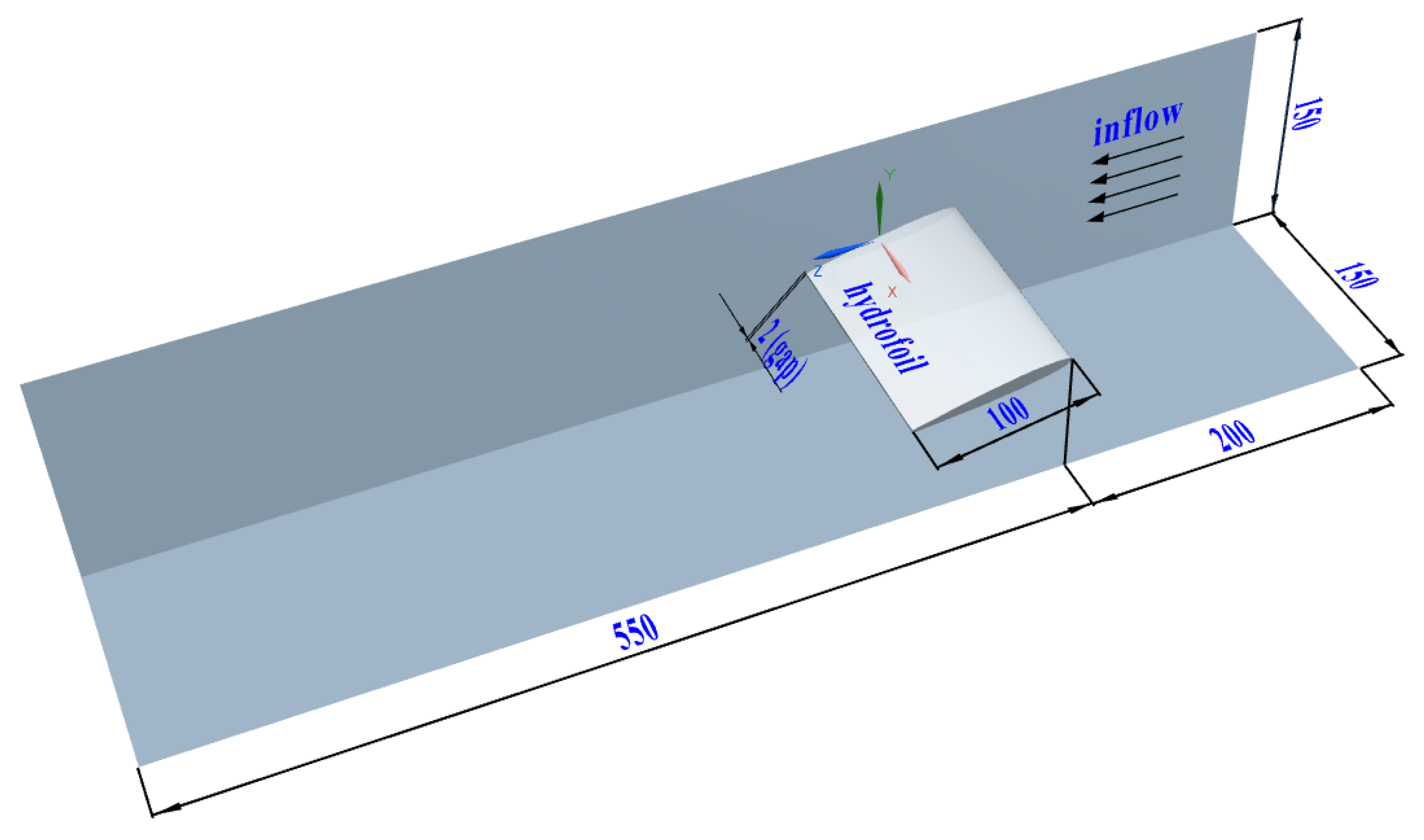
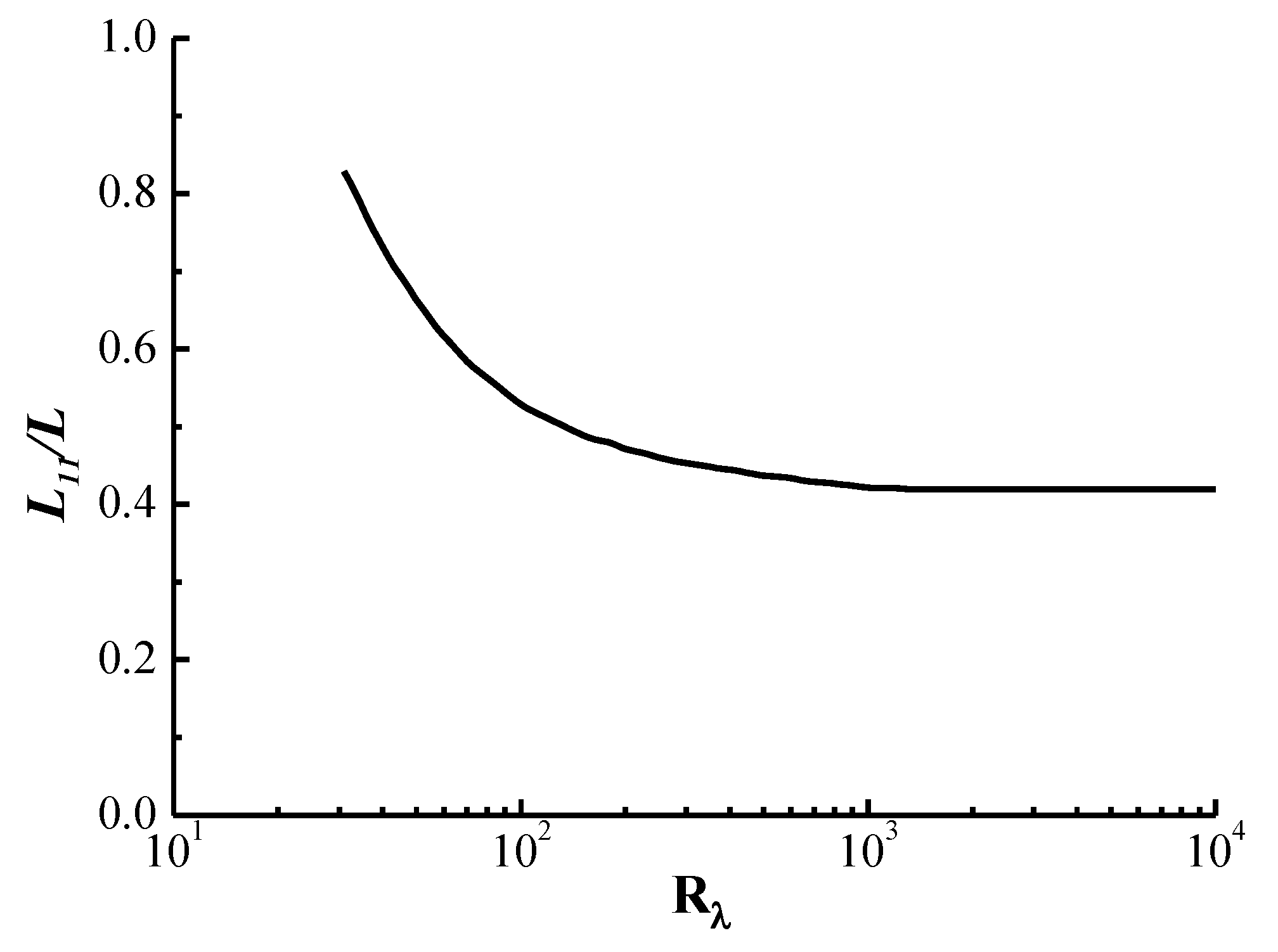
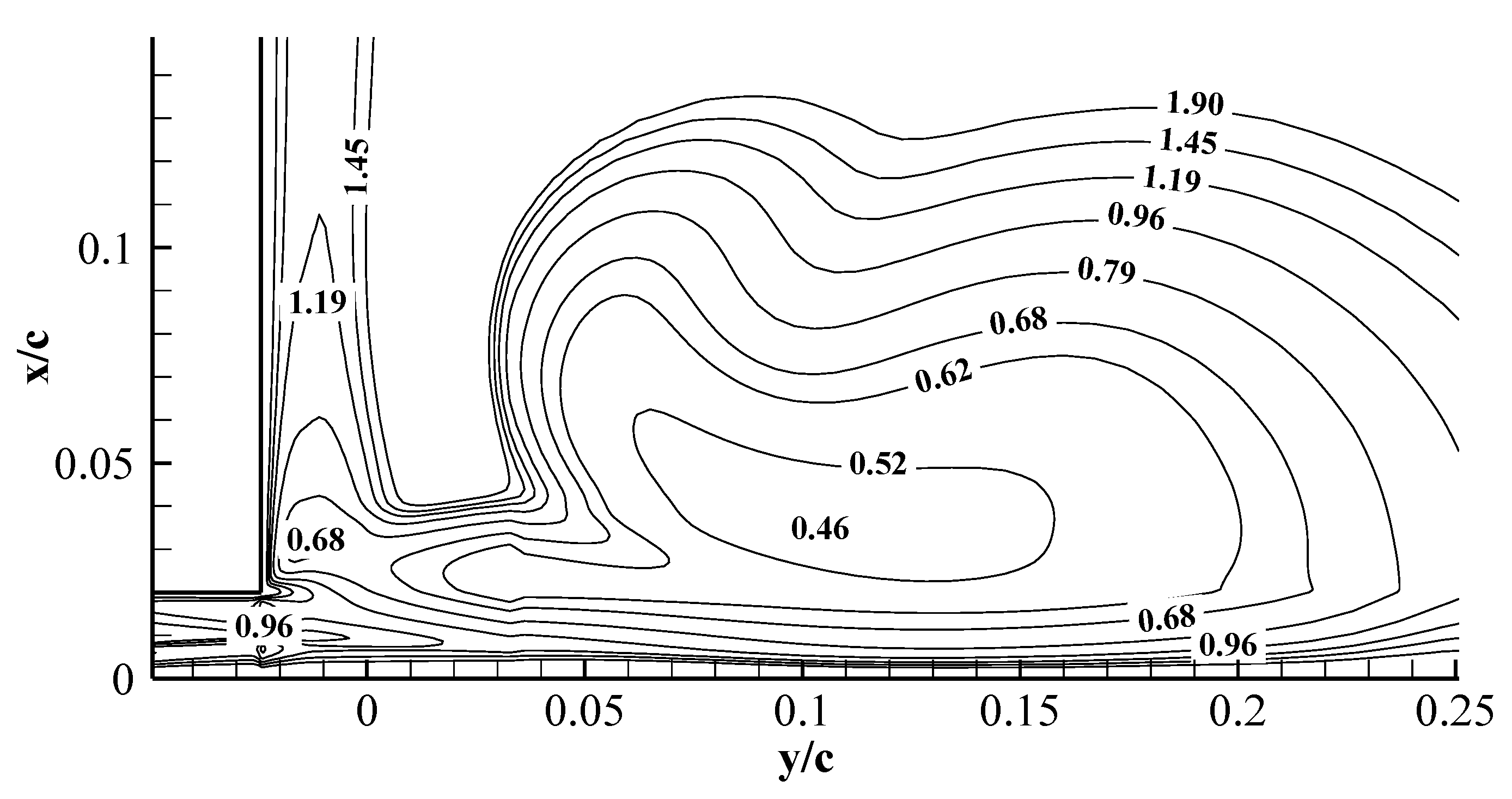


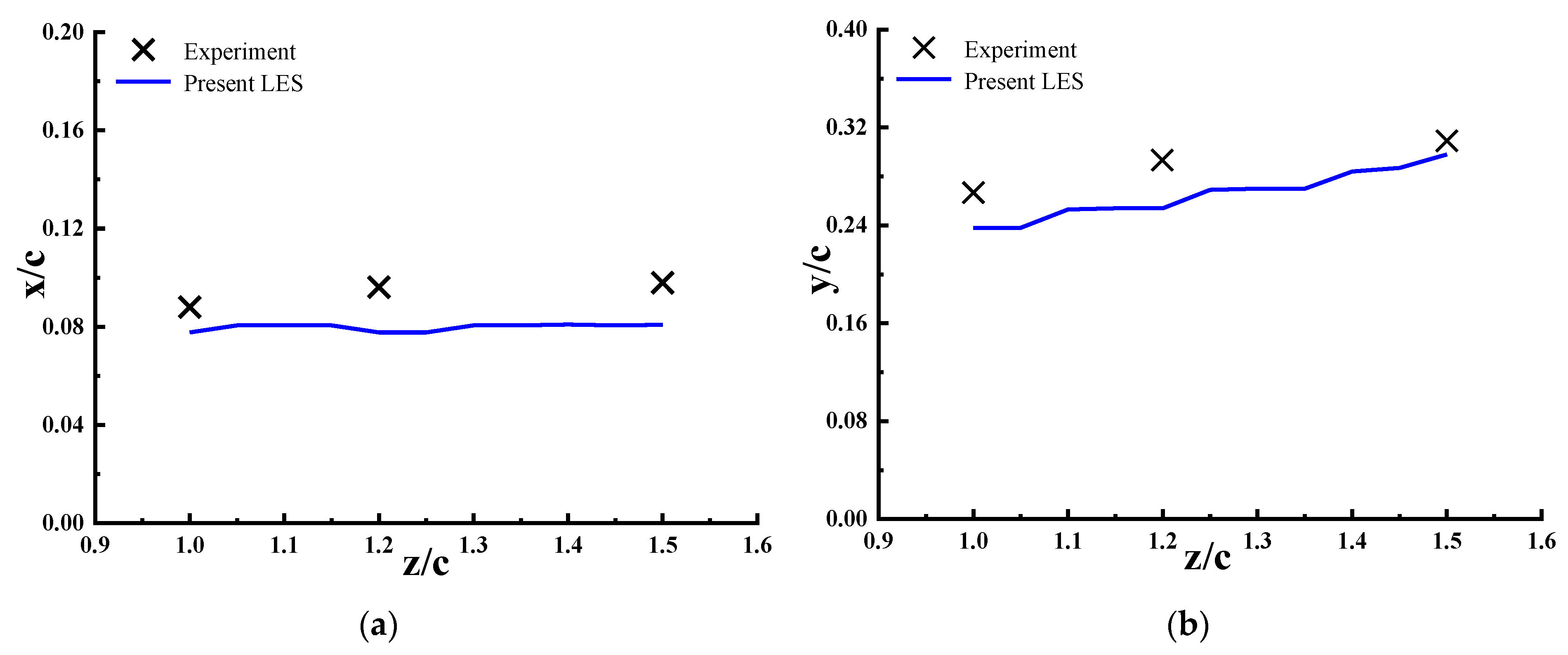
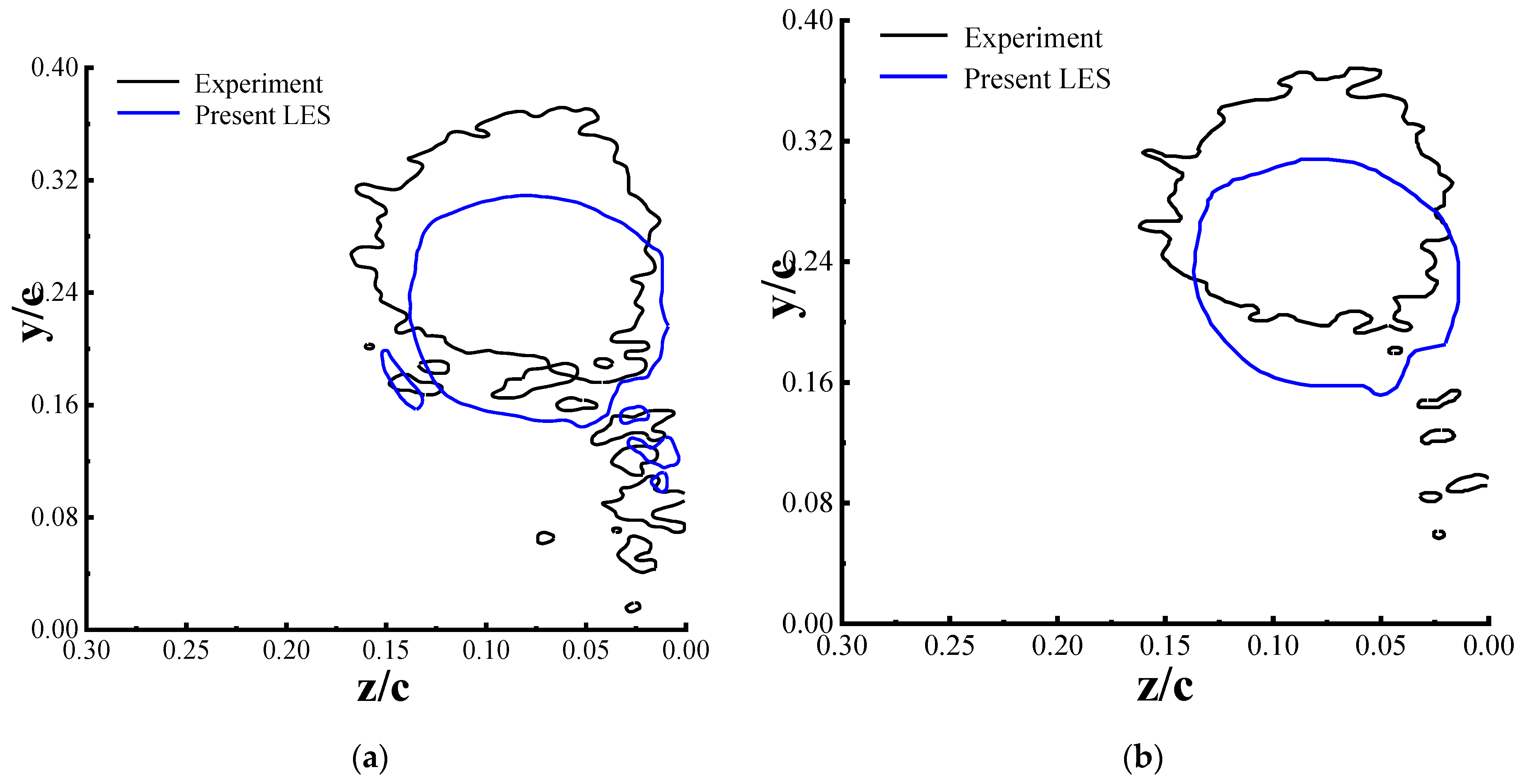

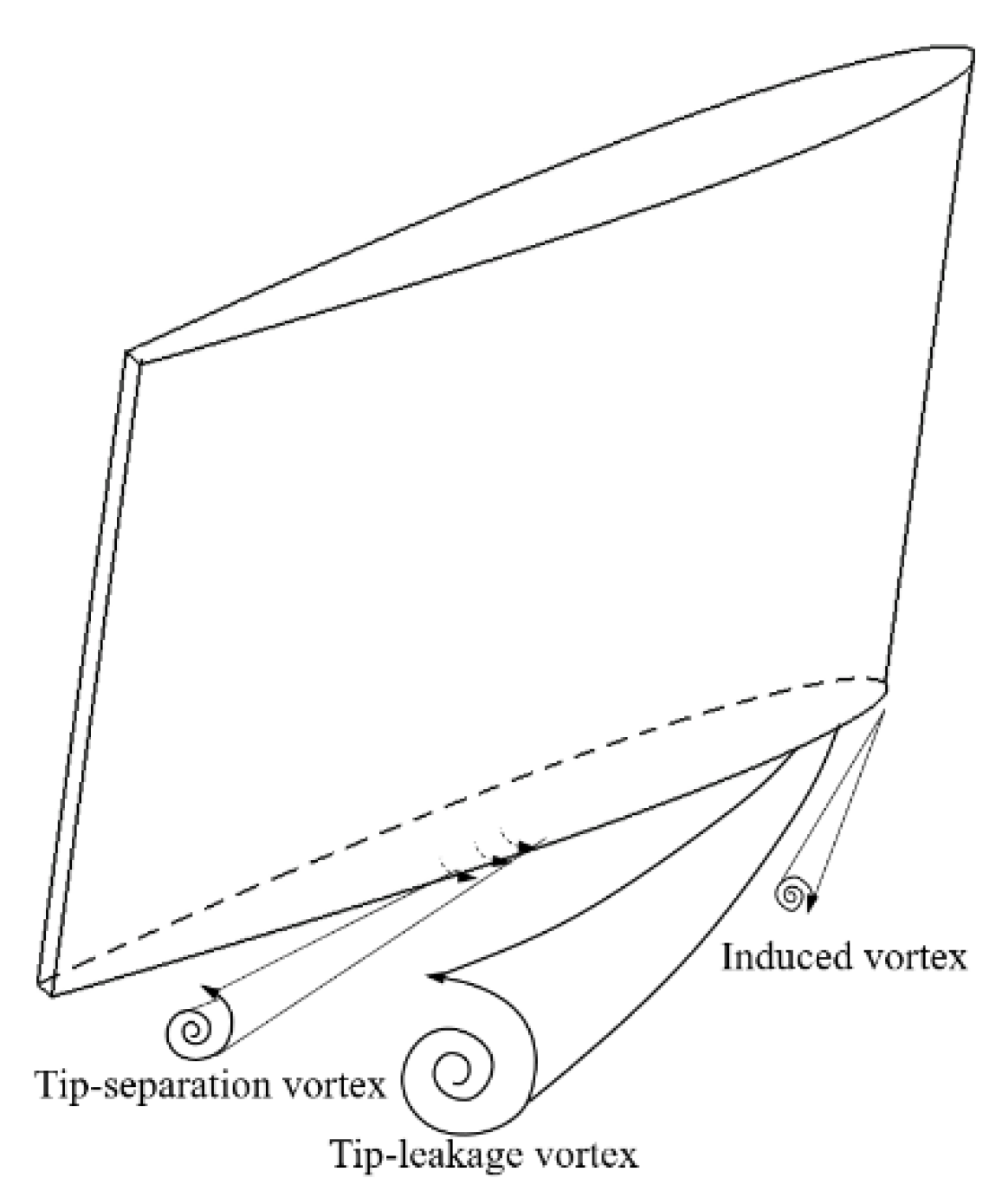
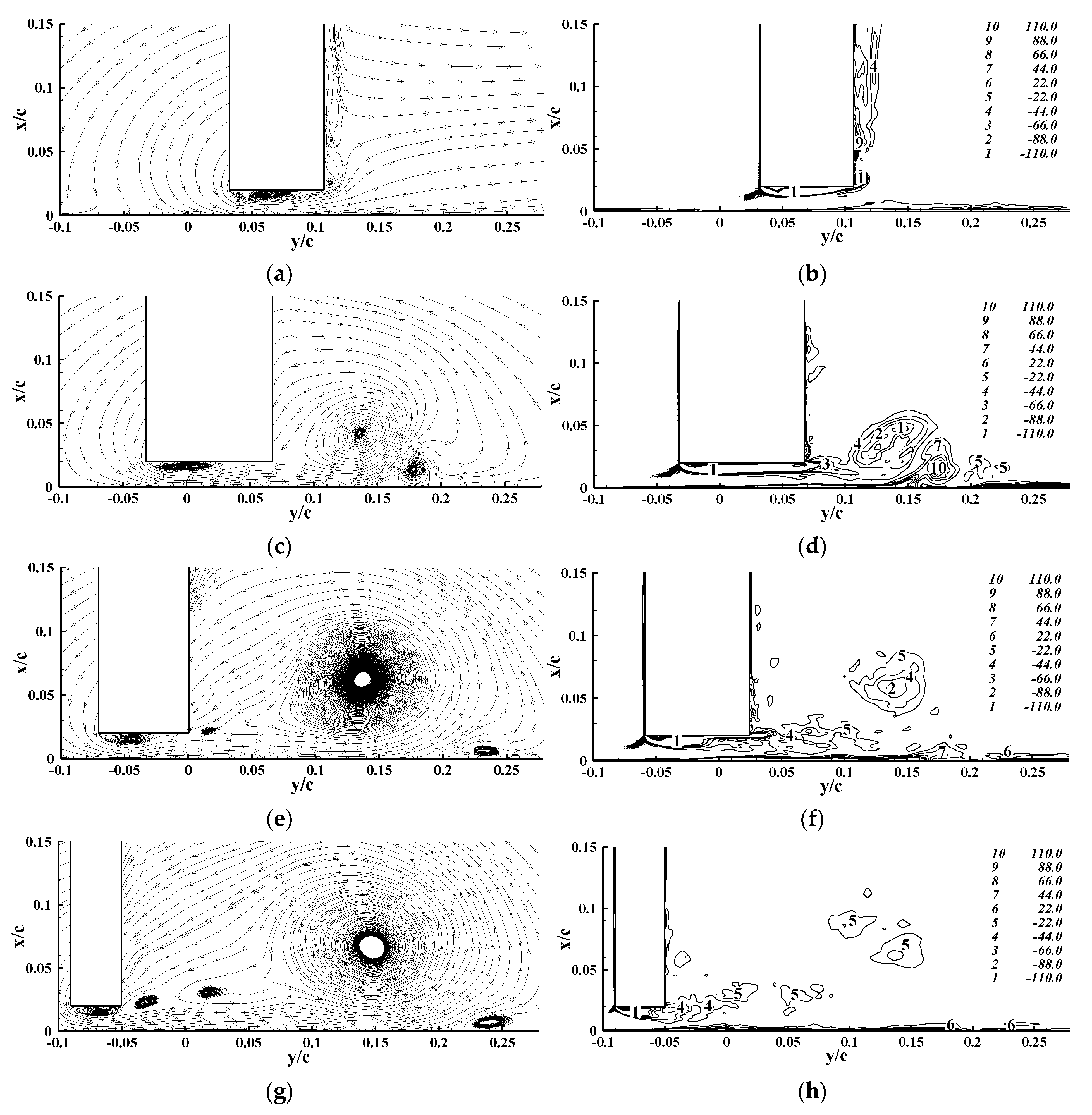
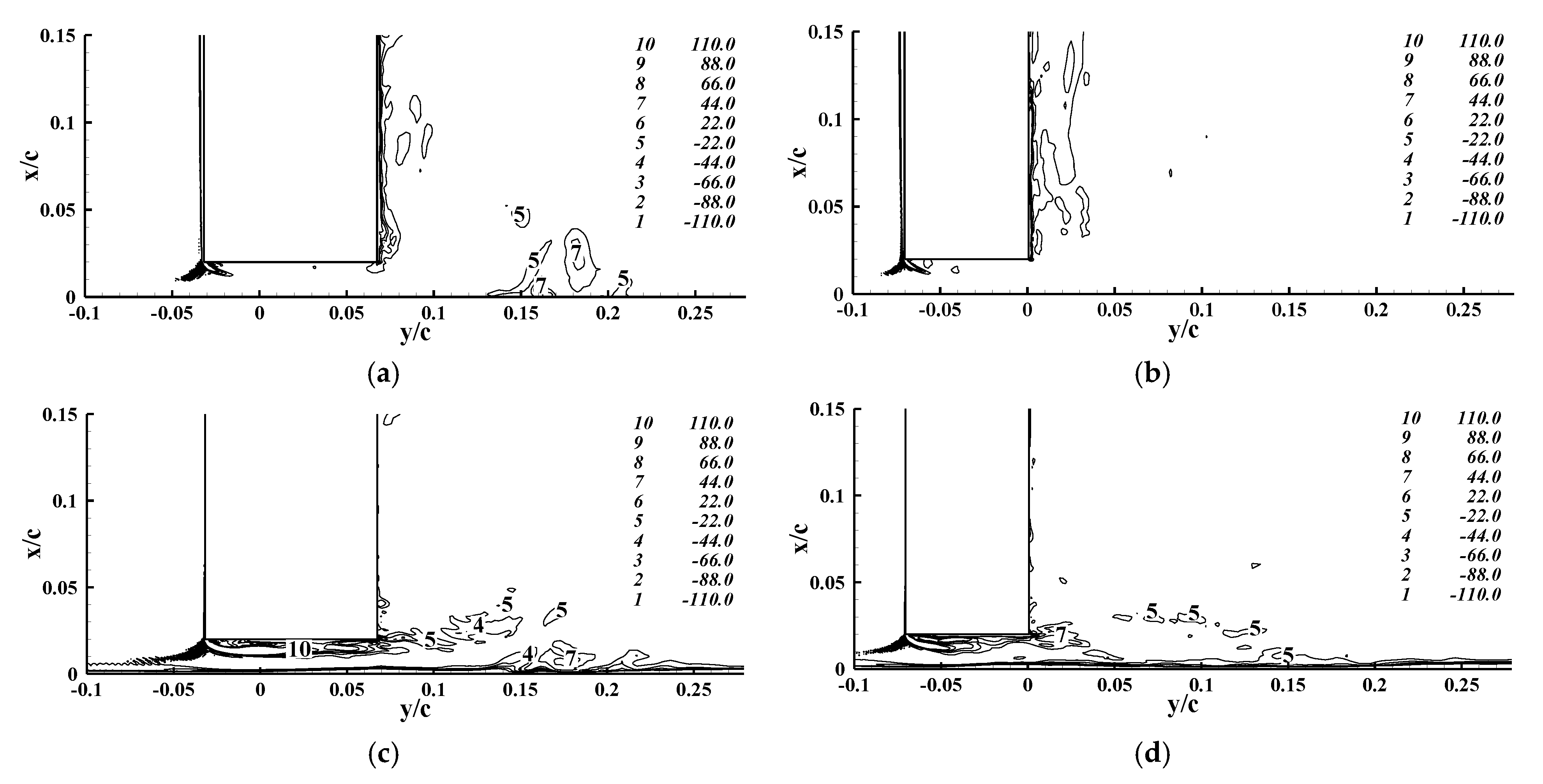


Publisher’s Note: MDPI stays neutral with regard to jurisdictional claims in published maps and institutional affiliations. |
© 2021 by the authors. Licensee MDPI, Basel, Switzerland. This article is an open access article distributed under the terms and conditions of the Creative Commons Attribution (CC BY) license (https://creativecommons.org/licenses/by/4.0/).
Share and Cite
Geng, L.; Zhang, D.; Chen, J.; Escaler, X. Large-Eddy Simulation of Cavitating Tip Leakage Vortex Structures and Dynamics around a NACA0009 Hydrofoil. J. Mar. Sci. Eng. 2021, 9, 1198. https://doi.org/10.3390/jmse9111198
Geng L, Zhang D, Chen J, Escaler X. Large-Eddy Simulation of Cavitating Tip Leakage Vortex Structures and Dynamics around a NACA0009 Hydrofoil. Journal of Marine Science and Engineering. 2021; 9(11):1198. https://doi.org/10.3390/jmse9111198
Chicago/Turabian StyleGeng, Linlin, Desheng Zhang, Jian Chen, and Xavier Escaler. 2021. "Large-Eddy Simulation of Cavitating Tip Leakage Vortex Structures and Dynamics around a NACA0009 Hydrofoil" Journal of Marine Science and Engineering 9, no. 11: 1198. https://doi.org/10.3390/jmse9111198
APA StyleGeng, L., Zhang, D., Chen, J., & Escaler, X. (2021). Large-Eddy Simulation of Cavitating Tip Leakage Vortex Structures and Dynamics around a NACA0009 Hydrofoil. Journal of Marine Science and Engineering, 9(11), 1198. https://doi.org/10.3390/jmse9111198







